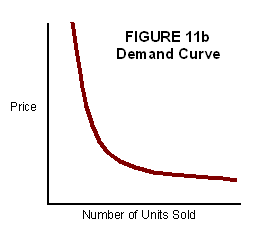Influence of Price on Demand
| Unit 11 |
Introduction | Legal Basis and Policy Issues | Determining Fee Levels | Deciding on a Fee Structure | Can Students Afford It? | Influence of Price on Demand | Providing for the Neediest Students |
In practice, the effective demand for any product in the marketplace will be influenced by a whole complex of variables. These include:
- the price of the product itself,
- whether substitute products are available and at what cost,
- the disposable income and tastes of potential customers,
- the availability of credit and
- how the product is promoted (Bates & Parkinson 1982, page 70).
However, in terms of an individual’s decision to enrol for studies with an ODL institution, price is the variable that is likely to have the greatest impact on demand. Figure 11b illustrates a typical demand curve which, in its ideal form, resembles a hyperbola.
As can be seen, a drop in the price of any product normally results in an increase in the number of units sold, whereas raising the unit price has the effect of decreasing sales. The influence of price changes on demand is referred to as elasticity, and this depends upon which part of the curve we are considering.
In the upper left-hand part of Figure 11b, relatively large changes in the price of a product are required to effect significant changes in demand. This would be the case with a luxury item such as diamond jewellery, where large discounts would need to be offered in order to increase sales by even a few percentage points. On the other hand, with some low-cost products, relatively small changes in price result in dramatic changes in demand, as can be seen in the lower right-hand part of the curve. Thus, for example, a supermarket may be able to double its sales of a non-perishable product, such as milk powder, if it lowers the price by only 10-20%.
For any particular product and price structure, empirical methods must be used to determine the relative elasticity of demand. While it can be difficult to test the impact of different fees on the demand for services, it may be possible to extrapolate the elasticity of demand by tracing historical changes in charges for ODL courses.
In a situation where the disposable income available to students is limited and fees are at a level close to the maximum they can afford, then the ODL institution may be reaching a tipping point. The idea is loosely borrowed from Gladwell’s best-selling book (2000) that analyses how small changes in fashion, politics and health can have surprisingly large effects on public attitudes and social behaviour. Under such circumstances, a relatively small increase in fees can give rise to a disproportionate decrease in student numbers.
A significant fall-off in enrolments for an ODL course or programme can also have serious consequences for the institution’s financial position. In the first instance, the amount collected in fees may actually decrease even though the fee per subject/course increases. Furthermore, the unit cost of providing these services will go up considerably. This is because a large component of expenditure for providing arises from the fixed costs of developing materials and the committed costs of employing full-time staff. With fewer students, these costs must be shared amongst a smaller pool of paying 'customers'.
If fees are formally linked to the real cost of providing courses, the institution will be trapped in a spiral of rising fees, falling learner numbers and increasing unit costs. Under such circumstances, the only option open to the institution would be to discontinue the course or, in a worst case scenario, to lay off permanent staff.
While it is difficult, at best, to make accurate predictions of how the public will react to different situations, nevertheless, any decision to raise fees should be taken in full knowledge of the potential consequences.
